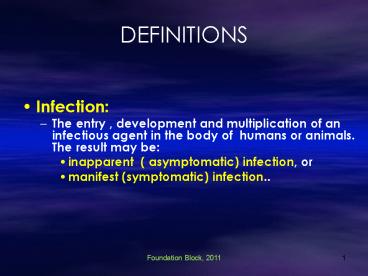DEFINITIONS - PowerPoint PPT Presentation
1 / 21
Title:
DEFINITIONS
Description:
DEFINITIONS Infection: The entry , development and multiplication of an infectious agent in the body of humans or animals. The result may be: inapparent ... – PowerPoint PPT presentation
Number of Views:48
Avg rating:3.0/5.0
Title: DEFINITIONS
1
DEFINITIONS
- Infection
- The entry , development and multiplication of an
infectious agent in the body of humans or
animals. The result may be - inapparent ( asymptomatic) infection, or
- manifest (symptomatic) infection..
2
DEFINITIONS
- Host
- A person or other living animal which harbours a
infectious agent under natural conditions . - Definitive host
- ( primary host) a host in which the parasite
passes its sexual stage. - Intermediate host
- (secondary host) a host in which the parasite
passes its larval or asexual stages.
3
DEFINITIONS
.
- carrier
- A person or animal that harbours a specific
infectious agent in the absence of discernible
clinical disease and serves as a potential source
of infection - pathogenesis
- Production and development of disease.
- pathogenicity
- Capability of an infectious agent to cause
disease in a susceptible host.
4
DEFINITIONS
- Parasitism
- A relationship in which an organism (the
parasite) benefits from the association with
another organism (the host) whereas the host is
harmed in some way. - commensalism
- Kind of relationship in which one organism , the
commensal , is benefited whereas the other
organism , the host , is neither harmed or helped
by the association.
5
DEFINITIONS
- ectoparasite parasite that lives on the outer
surface of its host. - endoparasite Parasite that lives inside its
host. - zoonosis Disease of animals that is
transmissible to humans .
6
Scientific names of parasites follow Zoological
Classification
7
CLASSIFICATION OF PARASITES
PROTOZOA HELMINTHS
Unicellular Single cell for all functions Multicellular Specialized cells
1Amoebae move by pseudopodia. 2Flagellates move by flagella. 3Ciliates move by cilia 4Apicomplexa(Sporozoa) tissue parasites Round worms (Nematodes) - elongated, cylindrical, unsegmented. Flat worms - Trematodes leaf-like, unsegmented. - Cestodes tape-like, segmented.
8
(No Transcript)
9
Examples of Diseases caused by Intestinal Protozoa
Parasite
Disease
giardiasis
Giardia lamblia
amoebiasis
Entamoeba histolytica
10
Giadria lamblia an example of Intestinal
Protozoa
11
Giardia lamblia Life cycle
12
Giardia cyst and trophozoites
13
Examples of Diseases caused by Blood and Tissue
Protozoa
Parasite
Disease
malaria
Plasmodium falciparum
Cutaneous leishmaniasis
Leishmania major
14
Malaria Species
Four species of malaria Plasmodium falciparum
causes malignant tertian malaria Plasmodium
vivax causes benign tertian malaria Plasmodium
ovale causes benign tertian malaria Plasmodium
malariae causes quartan malaria
15
LIFE CYCLE OF MALARIA
sporozoites
Pre-erythrocytic (hepatic) cycle
Exo-erythrocytic (hepatic) cycle
16
(No Transcript)
17
(No Transcript)
18
Cutaneous leishmaniasis caused by Leishmania
major
19
(No Transcript)
20
Resources on Parasitology
21
Resources on Parasitology
Centre for Disease Control and Prevention (CDC)
http//www.dpd.cdc.gov/DPDx/HTML/Para_Health.htm































